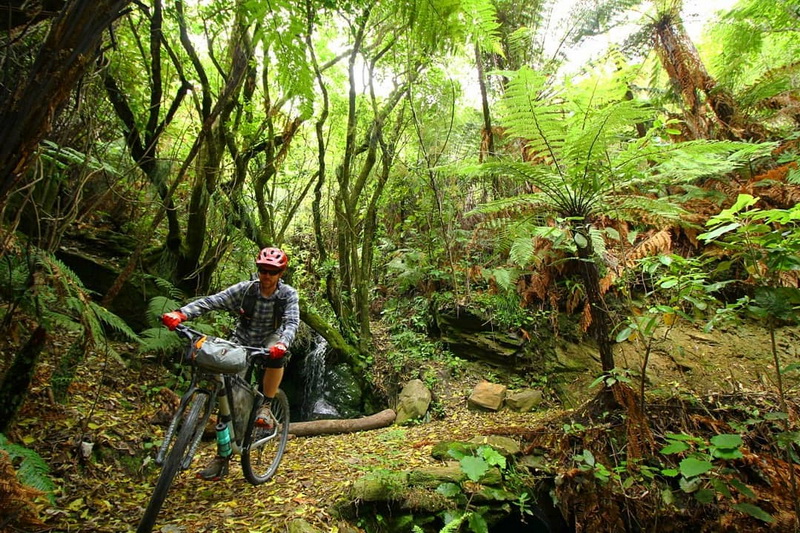
photo by Eszter Horanyi
Bike touring in New Zealand is hard.
Or at least we’ve found it to be. Rewarding, but challenging.
Partly it’s the terrain, partly it’s the weather. Partly it’s just that bikepacking ain’t easy. But it’s mostly just us that has made it hard.
In past years we have traveled to the country and carried everything by bike. We’ve lived/worked off the bikes for months. We didn’t have a set route or any goal other than to enjoy our time as we saw fit.
Last year we didn’t bring bikes at all — we purchased a car and focused on foot and packraft adventures. It was the smoothest of our three “winters” in the country.
So it was with some reluctance that I entertained Eszter’s idea to try bikes again. She had a loop around the “top of the south (island)” she had been dreaming of. As we talked it over and I looked at maps we figured a number of things would be different:
1 – Minimal highways. I have a very low tolerance for busy roads, especially NZ highways.
2 – A (mostly) set route. Less decision fatigue.
3 – More appropriate bikes. Hard tails that can handle trail but aren’t pigs on connecting roads (more on that later).
4 – Shorter time frame. This means I don’t have to carry a laptop/tablet for work, extra chargers and all the other things you need for 3 months of living.
5 – Go early (November) so we could ride a couple of long trails closed to bikes during high season.
More than all these things was the promise of time outside, with Eszter, seeing new country and enjoying life.
And so we launched. Would there be meltdowns? Major weather delays? Scary roads? Boiling sun? In NZ? Probably.
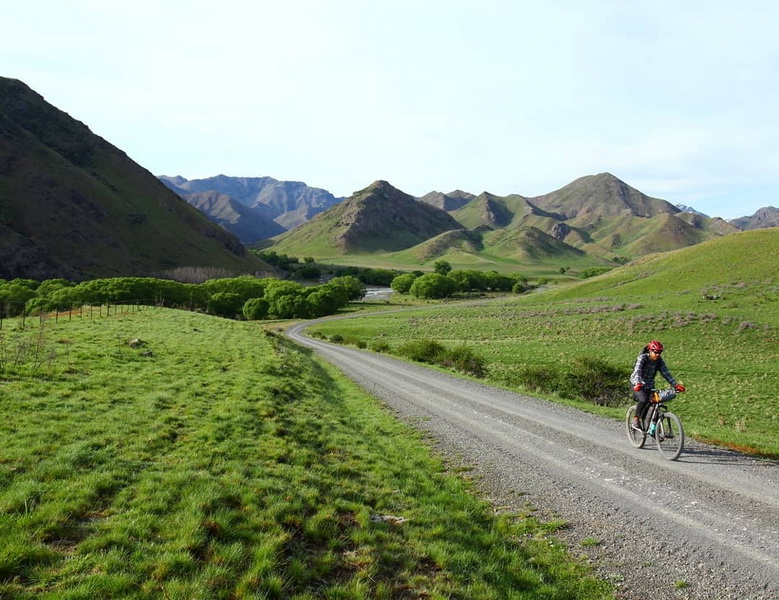
photo by Eszter Horanyi
First up was the Molesworth muster route. The first ‘track’ we ever rode in NZ.
It’s a lovely pedal with high country views and a very remote feel. We saw one or two cars the first day, waking to frozen water bottles at the Cobb Cottage.
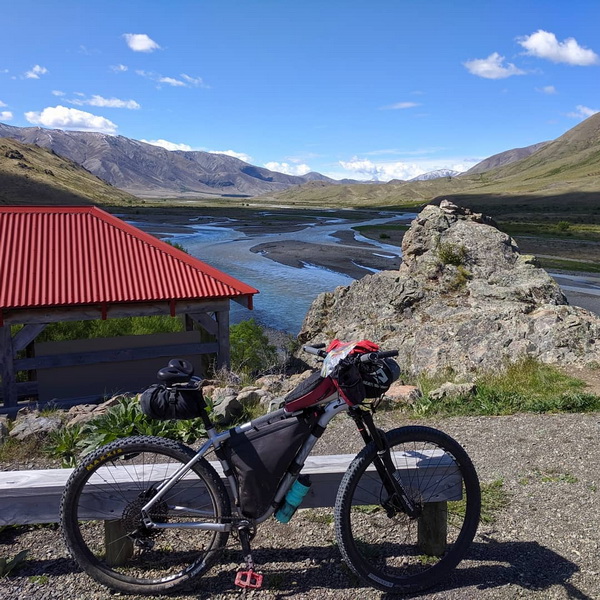
bike setup at an Acheron river confluence
Gear alert.
We haven’t ridden hard tail bikes for a decade or so. But for this loop and bikepacking in NZ in general, they make a lot of sense. We went with a setup that our good friend Scott Emmens calls a “brevet” bike. Something that is capable of riding semi-aggressive trail, but isn’t slow on roads.
Salsa Timberjacks fit the bill nicely. 130mm fork, dropper post, 2.3″ MTB tires. A very “middle of the road” setup, a basic mountain bike. And we loved it. (Note that the most expensive version of this bike retails for $2000).
Technical climbing and rugged conditions are generally my favorite type of riding. But I’ve learned a few things about myself as a mountain biker in recent years. The main thing being: what bike I ride matters less and less. I’m not a racer so I don’t care how fast I’m going. I’ve taken my “tech” game as far as I want to take it, and am not interested in pushing that much further (largely because of risk of injury). I have a pretty solid base of tech skills meaning I can fumble my way through moderately difficult trails on just about any bike. Thus, I really don’t need to worry about what bike I ride.
So a hard tail it was. The highest compliment a piece of gear can get is if it becomes invisible, and this bike did just that. I didn’t really think about what bike I was riding, it just did its job.
One thing that is important to me these days is comfort. For a three week trip we decided to go with flat pedals and running shoes. The giant frame bag on the Timberjack meant the heavy items (like avocados, peppers, hummus, cheese and salami as we almost always carried!) could ride low on the bike and my backpack was super light the entire time (with a little more effort I could have gone without a pack, but I do enjoy the convenience of access to all the pockets on a pack, especially the Ultimate Directions running packs we used). I also maximized comfort by going with the noseless spiderflex saddle. It definitely makes riding trail more challenging, but keeping pressure off sensitive areas is the only way I can stomach long seated climbs.
On to the ride…
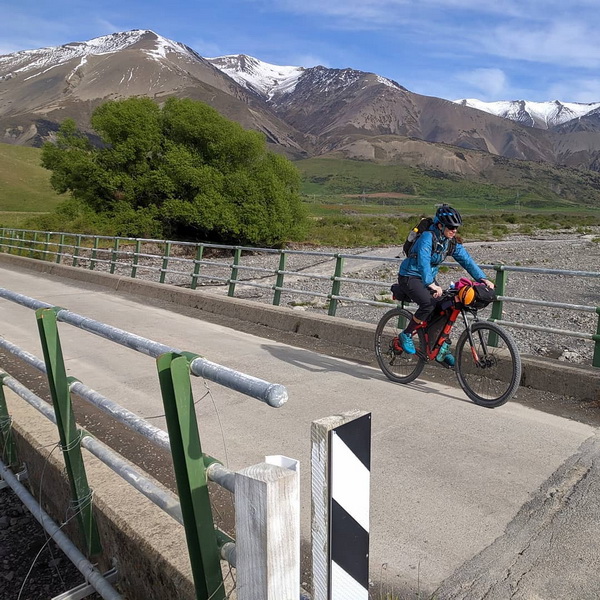
The second day on the Molesworth was marred by 160 KTM Rallye riders who had no respect for other road users. Eventually they cleared off and we were left with the peace and quiet we were seeking.
Things got a bit epic at the end of day 2. Strong winds that knocked us off our bikes came up in the afternoon. There was a protected campsite where we stopped for a snack and to assess food stores. Planning fail. We could stay but it would be a night of “dieting.” We reluctantly carried on to Blenheim into evening (luckily the sun is up until 9pm!), pedaling just to move down steep hills and generally suffering. Ah well, bikepacking isn’t supposed to be easy.
It improved from here. My knees ached from not being accustomed to riding flats+noseless and from the mileage in general. Gotta get over the hump of adaptation to longer days. I walked up a few steep hills along Port Underwood but we really enjoyed this quiet riding and being alone on the coast.
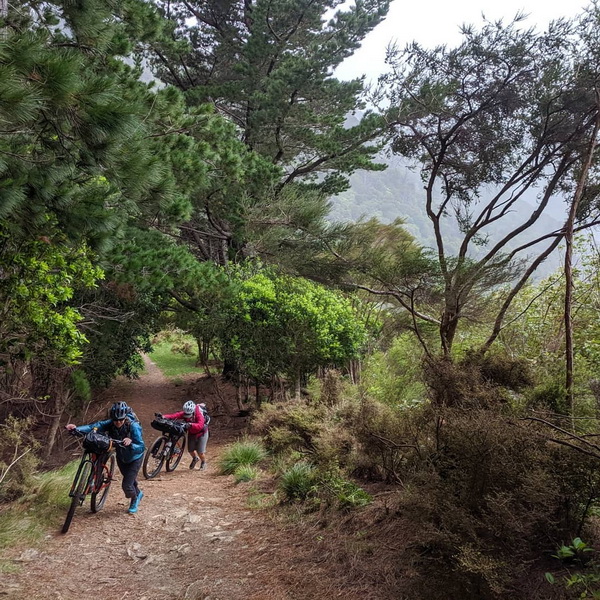
hike-a-bike!
In Picton we met up with Heather Rose, fresh off the plane from the states. Being able to ride with her helped push us over the top to make the trip and the (November) timing happen. It’s always good to see a friend in a foreign country.
Unfortunately she was getting over a stomach bug, so the first few days were a bit of a struggle for her. She toughed it out admirably.
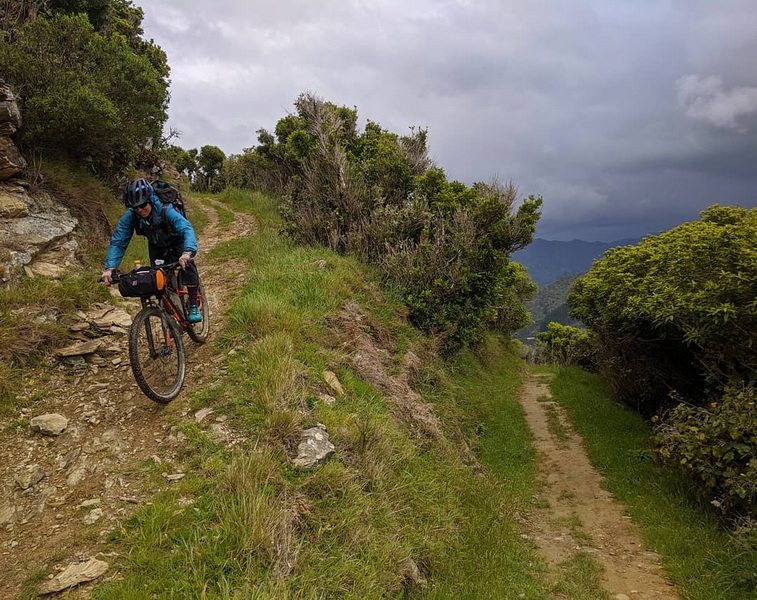
Then we started hearing rumbles in the distance. Thunderstorms are not all that common in NZ, but we were riding right into a huge one. And we were at the high point of the Queen Charlotte track — nothing higher anywhere around. Perfect.
The storm lost its strength as it came across, so we only got drenched rather than the hail and lightning that hit Canterbury that day. It was enough to turn us into “drowned rat” mode and the trail into a creek.
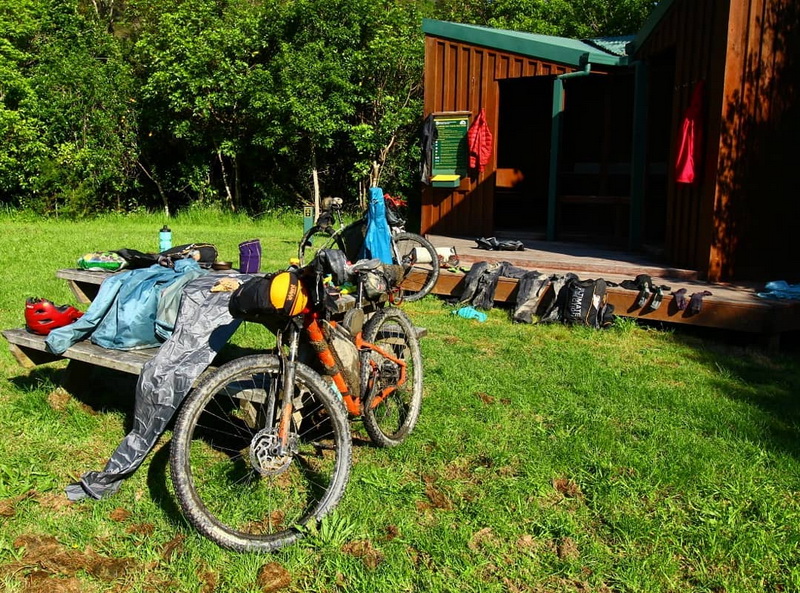
JUNK SHOW – photo by Eszter Horanyi
It was looking like a miserable and soggy night. We reached our campsite for the night and were shocked to find the beach full of kayaks and high school kids. Ugh. But going back into the trees there was a shelter and open grassy area. The sun came out, warming our skin and causing a full junk-show gear explosion. We couldn’t even hear the kids. What unexpected luck — it was a lovely night.
We continued pedaling some shorter days as Heather recovered and adjusted to longer days on the bike. It was good practice for us to stop earlier during the day and be in more of a ‘tour’ mode. I enjoyed it, but I think Eszter had a hard time not moving while conditions were still good.
Conditions were unquestionably good for the rest of our trip. November is spring and can have some unsettled and cold weather but it was never that hot or that cold at night, so it strikes a nice balance.
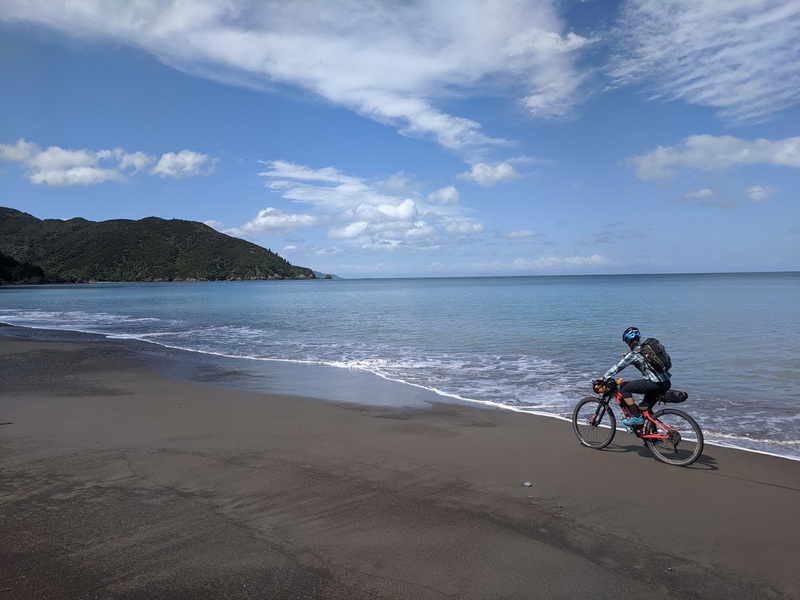
It was probably 30 degrees (F) cooler than when we rode the Great Taste trail to Motueka last. What a relief.
The next fun obstacle was Takaka hill. We surprised Heather by hitting the road early to beat traffic (we are not normally known for early starts or hustle). An alternating one-way section meant traffic really wasn’t a big issue climbing this anyway, but it was still great to have busted it out by 8am. This meant we had the rest of the day to do an unloaded day ride, chat with Ollie Whalley and crew and hike out to a vertical limestone cavern that is 357 meters deep (!).
In the morning we descended some 2500 feet on the lovely Rameka track. It’s a historic pack track that has been resurrected by mountain bikers. It exceeded all expectations. Good grade, good challenge, good views — perfect bikepacking singletrack and the descent felt endless. Kudos to the Rameka trust and the Kennetts on this one!
We pedaled on over to Chris Bennett’s house outside Takaka. He didn’t tell us about the 300 foot granny gear (!) climb to his door so we arrived sweaty and giggling about it. Chris was kind enough to invite us to stay a couple nights. The timing was good since I was tracking the Baja 1000 where stable internet and power are key. We also got to attend the Takaka short film festival with local and highly interesting entries.
For this trip I brought a foldable keyboard to use with my phone and wrote a few utilities so I could forgo a laptop that runs TopoFusion (which I use to do nearly all my GPX file manipulation). As it turned out Chris had a laptop and a copy of TopoFusion anyway!
I did get a phone call at 3am during the event with something to fix, but otherwise it was a smooth event.
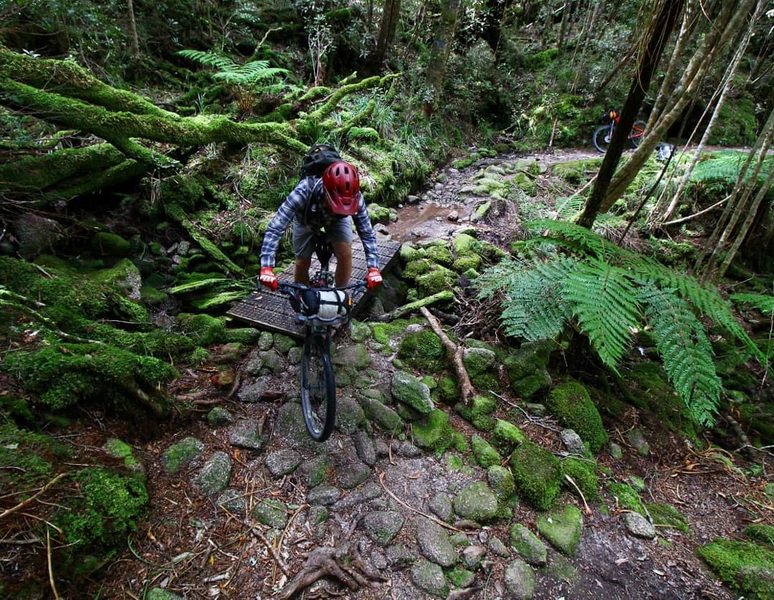
photo by Eszter Horanyi
Some sealed road and lots of gravel brought us to the centerpiece of our loop: the Heaphy Track. It travels across a remote corner of Kahurangi National Park, with both ends of the track 460km apart by road. The best way to do it may be as part of a thru-trip. Lucky us. Even more lucky that they allow mountain bikes on the track — until the busy season starts Dec 1. So again, the Nov start is key.
Eszter brought along my 7 year old DSLR and a new wide lens. I think she had a lot of fun setting up shots and seeing how they turned out. The photo above is one of my favorites. Our smaller cameras and phones never capture the “in the bush” riding, probably due to the lack of ambient light. She really upped the photo game on this trip and got some nice shots.
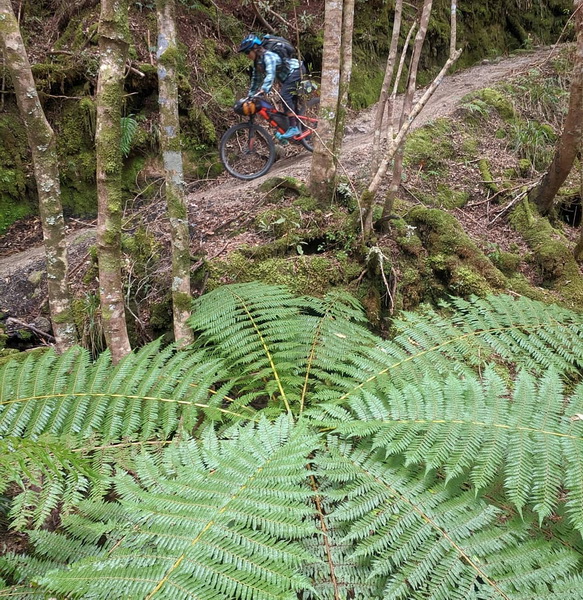
Heaphy was better than I expected. More engaging riding (despite being a ‘great walk’), more scenically interesting, more diverse. More sandflies than I thought, too!
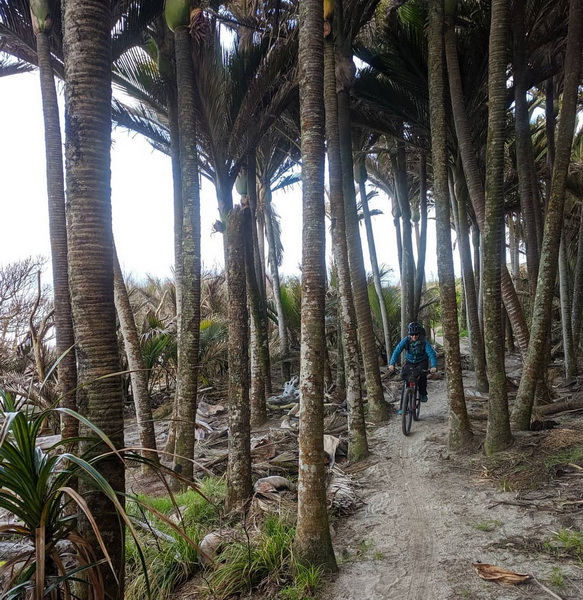
Following the Heaphy River out to the coast, weaving between Nikau palms and all manner of ancient trees, to a rocky and wild beach, the sense of place was overwhelming. We watched the tide come in violently as it mixes and backs up into the river flats. The hydraulics were crazy and unpredictable. No place to be in a packraft (for me, anyway!).
We also saw Takahe, a flightless bird that was thought to be extinct but is now rebounding. It was three days well spent. I would ride that track again in a heartbeat given the chance — but given the season and logisitics those chances are rare, indeed.
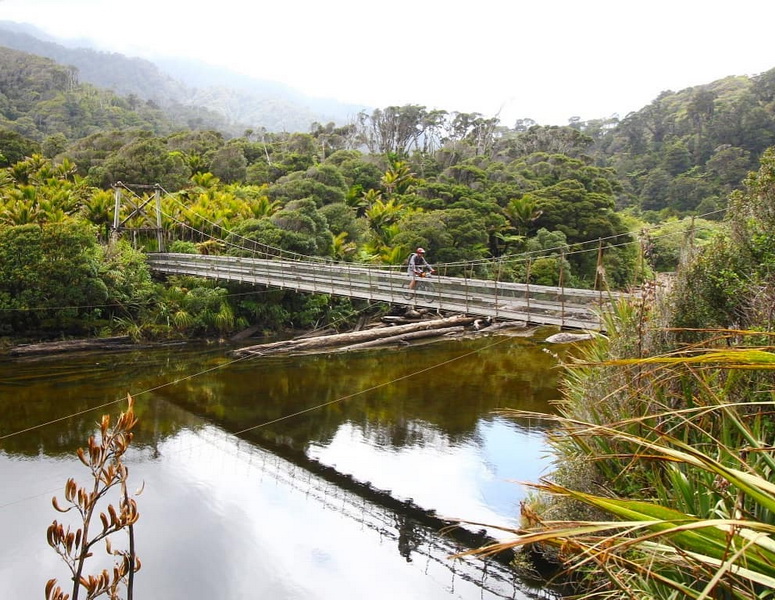
photo by Eszter Horanyi
Down the west coast the remaining days of our loop began to solidify, and the weather forecast was extremely favorable… for a few more days. We said goodbye to Heather in Karamea and started making tracks towards Hanmer Springs.
The recipe was: First week of bigger days for adaptation. 2nd week shorter days and more down time. Add a bunch of rewarding riding for extra stoke. Increase motivation with a good but limited weather window.
The result was a rhythm, a flow, a strength on the bike that is difficult to come by. No distance seemed too far, no hill too high. We blasted on to Mokinui. Thrashed some locals in pool (*), becoming the center of attention in the one pub town.
(*) 100% luck – they scratched going for the 8 ball.
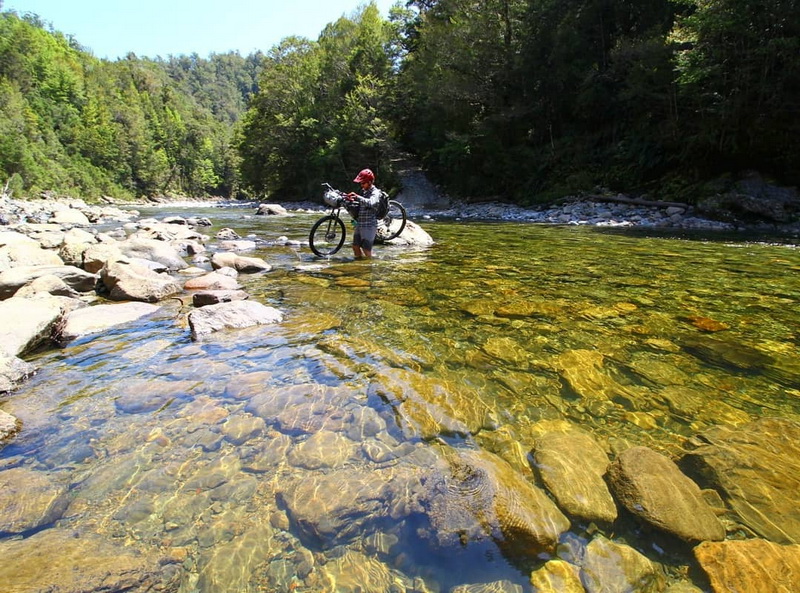
photo by Eszter Horanyi
Climbed the massive Denniston Plateau. Dug deep to grunt out an agonizing series of granny gear “lumps”, each more steep and more fiendish than the last. Forded the Mackley river. Continued climbing steep dirt with nary a person in sight. Wild camped strategically before the end, so that a toilet and highway ride could be done early before Murchison.
Braeburn and Porika tracks were not much of a challenge. Excellent cheese scones with butter in St. Arnaud. Add a flat white coffee and some curly fries and I was settling into my chair for a solid break after much enjoyable riding.
The only unknown left was the ‘off season’ Rainbow Road, which we never can get a straight answer on. I am pretty sure cyclists are almost always welcome but we get conflicting messages. The website was down and we had heard from an “overlander” that it might be closed for construction. Sipping coffee I said, “what we need is for a touring cyclist to roll up from the Rainbow right now.”
Not 20 minutes later two girls with panniers rode from the correct direction. Eszter went to talk to them since I didn’t even have my shoes on, I was so settled in. She came back and said, “pack up your stuff, we are heading out!”
Had they ridden the Rainbow? Yes! But they were told it was only OK to ride it through today — stock movements were happening tomorrow. Giddy up — time to make more km’s disappear.
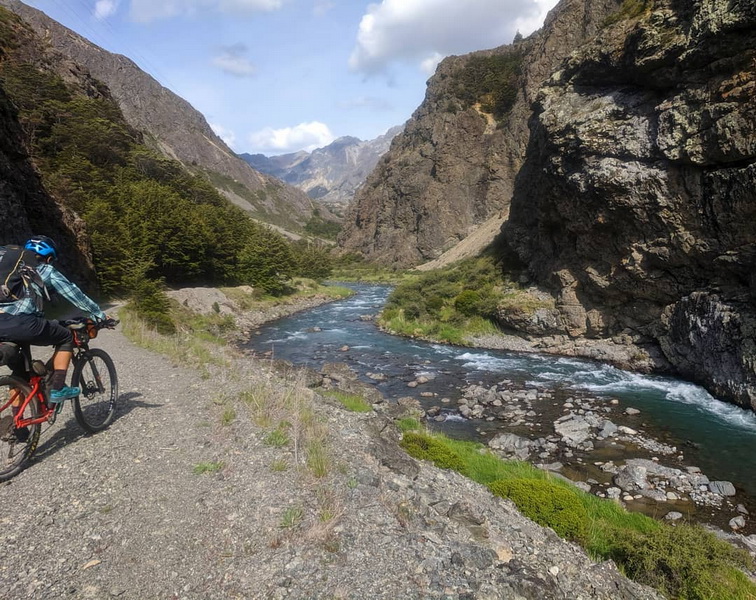
It was good fortune. A nice tail wind picked up as the evening went on, pushing us up the Wairau / Rainbow River valley. The sun was at our backs, lighting up the cliffs, the water, the gorge. It was simply stunning.
We reached the end of the locked / leased portion of the Rainbow Rd earlier than expected. Should we continue on, perhaps to a hut or further campsite? Yes, please! Conditions were just too good to stop riding.
And so the magic continued, until we got to within a few kms of the Sedgemere Sleepout hut. The front has pushed closer and was now spitting rain at us. Behind we could see darkness, and the wind was now gusting and changing. To the hut!
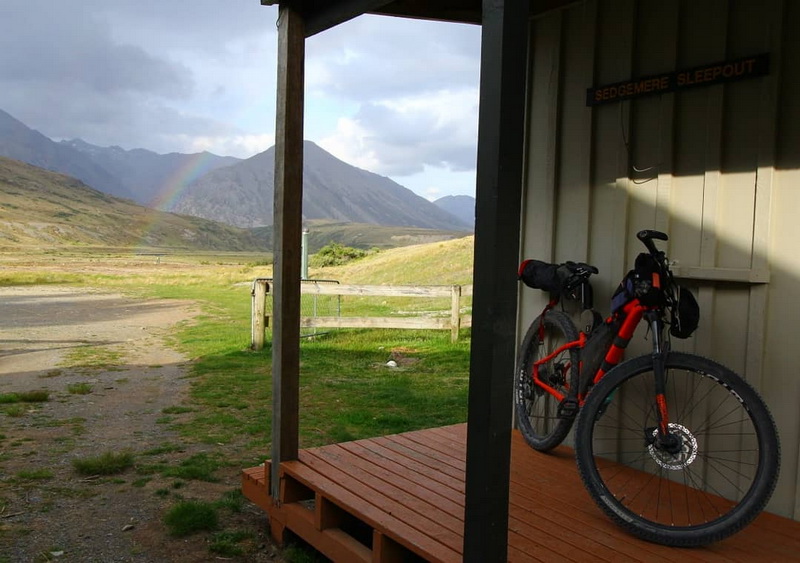
photo by Eszter Horanyi
We made it indoors with only a sprinkle or two, and boy were we happy for the shelter. Bad night to be tenting (mostly due to wind). We had picked up the six month hut pass, so our stay at this (empty) hut was free. Gotta love the hut system here.
We slept well but were up early, knowing the storm would probably only intensify. Rain and cold winds sparred with us climbing to Island Saddle, then the huge glacial valley coordinated things and turned the incoming weather into a ripping tail wind. We covered the remaining 40km of gravel in no time, marveling at our continued good fortune. A slight climb over Jack’s Pass brought us to the steep descent back into town. Loop complete — some 3 weeks and some 700 or 800 miles!
A speedy tour divide racer named Steve Halligan had been kind enough to store our car at his retreat / B&B while we were gone. He went a step further and invited us to stay after we finished the loop. Too often the end of a long trip ends with logistics, decisions and general stress. It meant so much to us to have a space to truly ‘retreat’ to after the loop, in order to attempt to understand it and process it. Just sit with it. And also to gorge on heaps of Indian and Thai food in town — an equally important part of the recovery process!
Meeting up with Heather, Steve, Ollie, Brian Alder and Chris Bennett meant it was a good tour of bikepackers — it was great to visit with them all. The bikepacking community rocks.
It was a fantastic loop. Look for it to appear on bikepacking.com, being written up by Eszter. I’m quite please we brought bikes this year and gave bikepacking here another go — under different terms. And now we have something we’ve never had: both a car and bikes. So we can do day rides we couldn’t really access before. Looking forward to the rest of the summer here!!
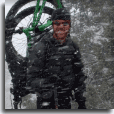


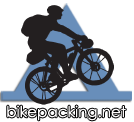
Leave a Reply